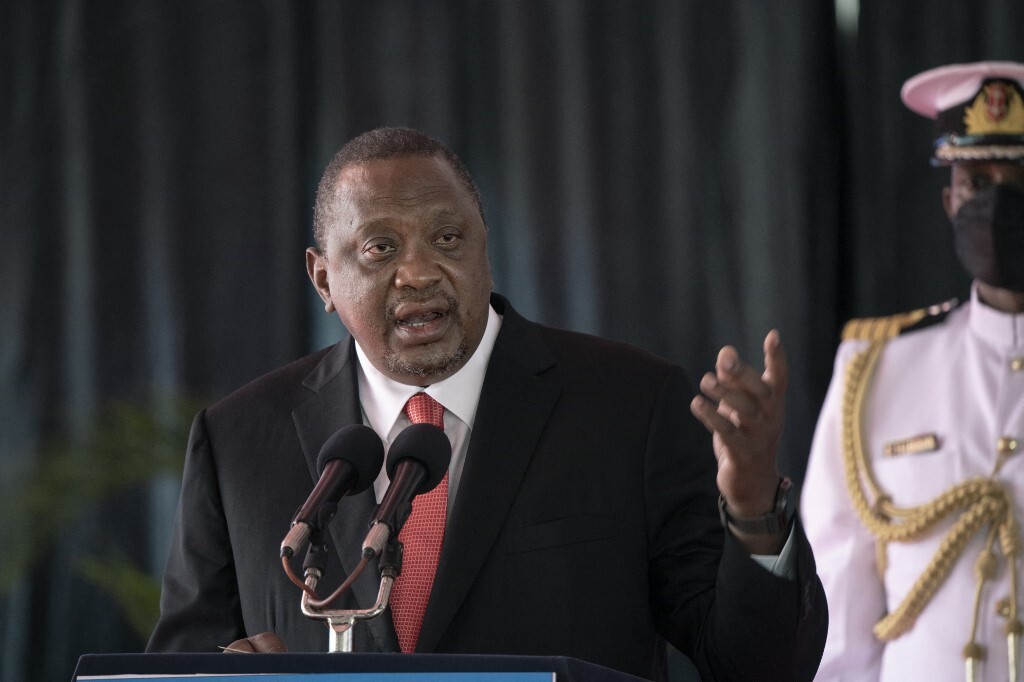-
The budget statement was correct about Kenya’s revenue growth over the past eight years, as well as increased earnings from the tourism sector and the number of schools built by the administration.
-
Despite also getting the growth in green energy sources and the number of title deeds issued by the government since 2013 mostly right, the minister was way off the mark with the majority of his claims.
-
Yatani’s claims about economic growth, inflation declines, a better police officer to citizen ratio, and the extent to which power generation has increased were all incorrect.
Kenya’s finance minister recently outlined the country’s spending plans in what was the final budget statement of president Uhuru Kenyatta’s administration.
Ukur Yatani made several claims in his speech, many of which resembled a scorecard of Kenyatta’s tenure. The president will step down after the August 2022 elections, having been in office since 2013.
Yatani’s speech covered several areas, from the economy and jobs to policing, health and education. We checked the numbers.
We contacted the national treasury’s spokesperson for the evidence for the minister’s claims. We will update this report once we receive his response.
Yatani said the Kenyan economy had “staged a strong recovery in 2021”, having weathered the shocks of the Covid-19 pandemic in 2020, when it contracted by 0.3%.
He gave the estimated growth for 2021 as 7.6%. But the national statistics office is yet to publish data for the year.
Vincent Kimosop is the founder of Sovereign Insight, a strategy and policy thinktank in Nairobi. He has also worked with the Kenyan government. To evaluate this claim, he referred us to the quarterly gross domestic product (GDP) reports published by the statistics office.
The most recent report showed an average growth rate of 7.9% from January to September 2021. The treasury also published a similar figure in February 2022.
Kimosop attributed the growth to the momentum generated by the lifting of lockdown restrictions.
“It is basically increased production that is attributed to increased engagement and activity in the economy. When you look at it from that perspective you will understand why that level of growth was recorded,” Kimosop said.
As Yatani also said, the growth is a result of recovery. But in the absence of publicly available data on growth in the last quarter of 2021 or clarification from his office, we rate his claim unproven. – Dancan Bwire
Gross domestic product (GDP) is a widely used measure of a country’s economy. It is the market value of all final goods and services produced in a country in a given period, usually a year.
Official data shows Kenya’s economy was valued at KSh4.7 trillion in 2013. The minister’s figure of KSh5.3 trillion was only attained a year later.
In February 2022, the national treasury provisionally estimated 2022 GDP as KSh12.6 trillion. After his budget speech, Yatani tabled a summary showing the same figure.
None of his GDP figures for either 2013 or 2022 are supported by publicly available information.
In March 2022 we fact-checked a claim by Kenyatta that the economy more than doubled during his administration. We found this to be misleading.

Yatani’s claim of a 155% increase in the economy’s size, which he described as a “monumental milestone”, also leaves out key context. During Kenyatta’s administration the GDP was rebased twice, in 2014 and in 2021.
Yatani also omitted the increase in the country’s public debt which analysts say has driven the bulk of economic activity as measured by GDP.
GDP ‘not a measure of societal progress’
But there are also challenges with using GDP to show gains, Margarida Domingues de Carvalho, who works with Eurostat, the statistical office of the European Union, told Africa Check.
“GDP is often misinterpreted as a measure of societal progress and well-being, which it is not,” she said in an email.
“GDP and GDP growth only give indications on the size and dynamics of an economy, but say nothing about, for example, the distribution of income and wealth or possible adverse environmental effects of the economic activity.”
Yatani gets the growth figures for 2013 and 2022 wrong, leaves out important context, and inaccurately uses GDP to signal progress. – Makinia Juma
The country’s statistics bureau publishes data on the number of jobs created in its annual economic survey.
We checked the surveys released in 2018 and 2020.
|
New jobs created from 2013 to 2019 |
||
|
Economic survey 2018 |
Economic survey 2020 |
|
|
2013 |
755,800 |
|
|
2014 |
802,200 |
|
|
2015 |
844,500 |
847,300 |
|
2016 |
832,000 |
807,100 |
|
2017 |
897,800 |
905,900 |
|
2018 |
824,900 |
|
|
2019 |
846,300 |
As seen in the table, there are discrepancies in the numbers. But the total falls between 5.79 and 5.8 million jobs created between 2013 and 2019.
The most recent survey was published in 2021. It showed that as of June 2020, the number of jobs shed due to the pandemic was 737,500.
Cumulatively, that would reduce the jobs created in the period to 5 million. There were also reports of more job losses in 2021. But without data for this year, we cannot fully evaluate the minister’s claim. – Grace Gichuhi
Inflation measures “how much more expensive a set of goods and services has become over a certain period of time, usually a year”, according to the International Monetary Fund.
We looked at economic survey data to track inflation.
|
Average annual inflation rates from 2013 to 2021 |
||||||||||
|
Year |
2012 |
2013 |
2014 |
2015 |
2016 |
2017 |
2018 |
2019 |
2020 |
2021 |
|
Inflation (%) |
9.4 |
5.7 |
6.9 |
6.6 |
6.3 |
8 |
8 |
5.3 |
5.4 |
6.1 |
Sources: Economic surveys 2015, 2016, 2017, 2018, 2019, 2020, 2021 and the quarterly economic and budget review report of February 2022.
The average annual inflation rate was 5.7% in 2013, not 7.2% as the minister claimed. In 2021, a treasury report showed inflation was 6.1%.
Inflation did not decline, in fact it rose from 5.7% in 2013 to 8% in 2018. The most recent data shows that it was 6.1% in 2021, higher than it was in 2013. – Tess Wandia
Kenya’s central bank defines remittances as “money sent by a person in a foreign land to his or her home country”.
The bank records remittances using the US currency. For 2013, remittances were valued at US$1.29 billion. For 2021 they were $3.72 billion. The change between the two figures is 188%.
However, in Kenyan currency, and using the average exchange rates for the two years, the increase worked out to 279%, which is not very far from the minister’s 300%.
But there are two important caveats. First, the Kenyan shilling has sharply depreciated against the US dollar in that period. Second, the central bank has data up to February 2022, not the whole year as per the minister’s statement. – Dancan Bwire
Ordinary revenue includes all taxes collected by the country’s tax authority plus the appropriation-in-aid.
Appropriation-in-aid refers to “revenue in the form of receipts from user charges, collected by ministries or departments that is over and above the required amount and is spent by the entity that raised the revenue”.
National treasury data showed the total ordinary revenue was KSh875.5 billion in 2012/13. During his budget speech Yatani tabled a document showing the actual revenue for the 2020/21 financial year was KSh1.8 trillion. In the previous three financial years, revenue rose from KSh1.5 trillion to KSh1.8 trillion.
The tax authority has attributed the increased revenue to using technology, public awareness and an expansion of the tax base.
We therefore rate Yatani’s claim as correct. – Alphonce Shiundu
Kenya’s national statistics office does not release data on poverty annually, analysts have told Africa Check.
The most recent official statistics, released in 2018, had data for 2015/16. This defines “overall poverty” as households and individuals whose monthly expenditure “is less than KSh3,252 in rural and peri-urban areas and less than KSh5,995 in core-urban areas”.
It gives the national poverty headcount rate as 36.1%, a fall from the 2005/06 rate of 46.6%
Therefore, in 2013, the available data had the poverty rate at 46.6%. In 2019, the data showed it was 36.1%.
In 2021, the Kenya Institute of Public Policy Research and Analysis, a government thinktank, said more Kenyans had fallen into poverty as a result of the Covid-19 pandemic.
The thinktank estimated the 2019 poverty rate at 28.9% and the 2020 rate at 41.9%. None of these estimates support the minister’s claim. – Tess Wandia
The police-population ratio indicates the number of police officers serving a community, relative to its size. For example, if a community has one police officer serving 100 people, the ratio is 1:100.
Before 2013, data on the number of all police officers in Kenya was not publicly available. The economic survey only published the numbers for the Kenya police service, but left out the administration police service.
However, in 2013 when Kenyatta took office there were 75,325 police officers in Kenya, according to the national police service. That year Kenya’s population was 41.8 million, official data shows. This made for a police-to-population ratio of one officer for every 555 people.
The most recent economic survey put the number of police officers at 100,481 in 2020, while the estimated population was 48.7 million, for a police-to-population ratio of 1:485.
We therefore rate this claim as incorrect. – Tess Wandia
Kenya’s statistics agency publishes figures on the country’s power generation. The data comes from the electricity utility Kenya Power and the power-generating company KenGen.
In 2013, the country had 1,717 megawatts (MW) in installed capacity according to the economic surveys for 2014 and 2015. Installed capacity refers to the maximum capacity that the electricity system is designed to run at. Kenya Power put the figure at 1,765 MW as of 30 June 2013.
The closest to Yatani’s figure of 1,300 MW was in 2009 when it was at 1,311 MW.
According to the most recent economic survey, the country’s installed capacity was 2,836.7 MW in 2020.
Kenya Power’s most recent annual report showed that Kenya had 2,984 MW in installed capacity as at 30 June 2021, a figure also cited by the energy regulator, the Energy Petroleum Regulatory Authority.
We therefore rate this claim as incorrect. – Makinia Juma
Yatani said green sources currently account for 73% of Kenya's installed power generation capacity.
These sources include geothermal, wind, solar and hydro power.
The most recent data from the country’s state-owned utility, Kenya Power, showed a total installed capacity of 2,984 MW in 2021 broken down as follows:
|
Green energy sources in Kenya (2021) in MW |
|||||||
|
Source |
Hydro |
Geothermal |
Wind |
Solar |
Total from green sources |
Total installed capacity |
% of green sources |
|
2021 |
838.4 |
863 |
436.1 |
90.3 |
2,227.8 |
2,984 |
74.7% |
We rate this claim as mostly correct. – Makinia Juma
According to the lands ministry, the government issued 5.1 million title deeds from 2013 to 2021.
From 2013 to April 2020, 4.4 million titles were issued. At least 1.26 million deeds were given out from 2018 to April 2020.
Africa Check previously asked the lands minister for data on title deeds issued since April 2020 but has not yet received a response.
Only the ministry can confirm the number of deeds it has issued, the Kenya Land Alliance, a not-for-profit organisation that advocates for land reform in the country, told Africa Check.
Yatani’s claim that the current administration has issued 5.3 million title deeds over the last eight years is mostly correct. – Makinia Juma
Data from the national statistics office showed that in 2013, Kenya earned KSh94 billion from tourism.
The most recent data showed that earnings were KSh163.6 billion in 2019. The increase is 74%.
Tourism receipts dropped to KSh91.7 billion in 2020 due to rules that restricted travel because of the Covid-19 pandemic.
|
Kenyan tourism earnings |
|
|
Year |
Amount, billions |
|
2013 |
93.97 |
|
2014 |
87.08 |
|
2015 |
84.60 |
|
2016 |
99.69 |
|
2017 |
119.90 |
|
2018 |
157.38 |
|
2019 |
163.55 |
Yatani’s claim is correct. – Grace Gichuhi
According to the economic survey 2021, hospital bed numbers increased from 64,844 in 2016 to 82,091 in 2020, a 9.6% increase.
The statistics bureau said its data was from the Kenya Master Health Facility List, an application with all health facilities and community units in the country, compiled by the health ministry.
|
Hospital beds in Kenya 2016 to 2020 |
||
|
Year |
Hospital beds |
Increase |
|
2016 |
64,844 |
- |
|
2017 |
67,195 |
2,351 |
|
2018 |
71,601 |
4,406 |
|
2019 |
74,868 |
3,267 |
|
2020 |
82,091 |
7,223 |
Source: Kenya National Bureau of Statistics
We were however unable to find data from 2013 to 2015, making it difficult to verify the claim. We have contacted the health ministry and will update this report with their response. Until then, we rate the claim as unproven. – Dancan Bwire
Data from the education ministry shows Kenya had 26,549 primary schools in 2012. The number increased to 32,437 in 2020, according to the national statistics office.
The data also shows secondary schools increased from 7,174 in 2012 to 10,413 schools in 2020.
Based on the available data, the claim is correct. – Makinia Juma
In education, the term transition refers to the progression of students between different stages in the school system. It can be between grades within a given level, from one level to the next, and out of and back into schools.
In Kenya, the transition rate refers to the movement from pre-school into primary, from primary to secondary education, and from secondary to tertiary institutions.
Yatani’s speech focused on the primary into secondary transition rate, where candidates who sat their Kenya Certificate of Primary Education (KCPE) exam subsequently joined secondary school.
The 2016 economic survey puts the 2012 transition rate at 64.5%. The most recent data from the agency gave the transition rate for 2020 as 91%, a rise of 5.5 percentage points from 85.5% in 2019.
The ministry’s data confirms the transition rate in 2012 was at 64.5% but there isn’t publicly available evidence yet to prove it’s at 100% in 2022, as Yatani claimed. – Makinia Juma
John Kinuthia is a senior programme officer with the Kenya office of the International Budget Partnership, a global budget transparency organisation.
He told Africa Check that per capita income is measured by looking at the average income per person in a country. “So we look at total earnings then divide that by the total population. This is often used to gauge the standard of living in a country.”
Kinuthia directed us to gross national income per capita figures as published by Kenya’s statistics office in its annual statistical abstract.
The most recent abstract put the per capita gross national income at KSh125,845 for 2013, and gives a provisional figure of KSh217,200 in 2020.
The data agency has not released figures for 2021. We can therefore only rate this claim as unproven.
Kinuthia said there were varying opinions as to the usefulness of such measures in countries with large inequalities like Kenya.
“Those who make the most are very few,” he said. This risked skewing the data. – Makinia Juma







Add new comment